The state of Washington is known for wet weather, great forests, and stunning mountain vistas. The Evergreen State is mild, giving the native plants and wildlife a great chance to flourish — even snakes.
Although Washington’s cooler climate makes life more difficult for snakes, there are about a dozen native snake species. There’s a boa, rattlesnake, and even one with a pointy tail — and you’ll find three garter snake species in the state.
1. Northwestern Garter Snake (Thamnophis ordinoides)
The most common snake in Washington state is the northwestern garter snake. It’s not as widespread as other species, but what it lacks in range it more than makes up for in numbers. Their population centers are in the coastal regions of Washington and Oregon with a small chunk in northwestern California and southwestern British Columbia, Canada.
Northwestern garter snakes relatively small and adults average between 13 and 38 inches long, but rarely grow longer than 24 inches. They’re usually brown, slate gray, or black with three stripes — one dorsal and two lateral stripes.
In Washington, you’re most likely to see one of three variations:
- Dark body color with turquoise, green, blue, or yellow dorsal and lateral stripes
- Brown body color with yellow stripes and two rows of small dark spots above their lateral strips
- Dark brown or black dorsal color with red dorsal and yellow lateral stripes.
These snakes prey on slugs, salamanders, and frogs, so their habitat has to be moist enough to support these animals.
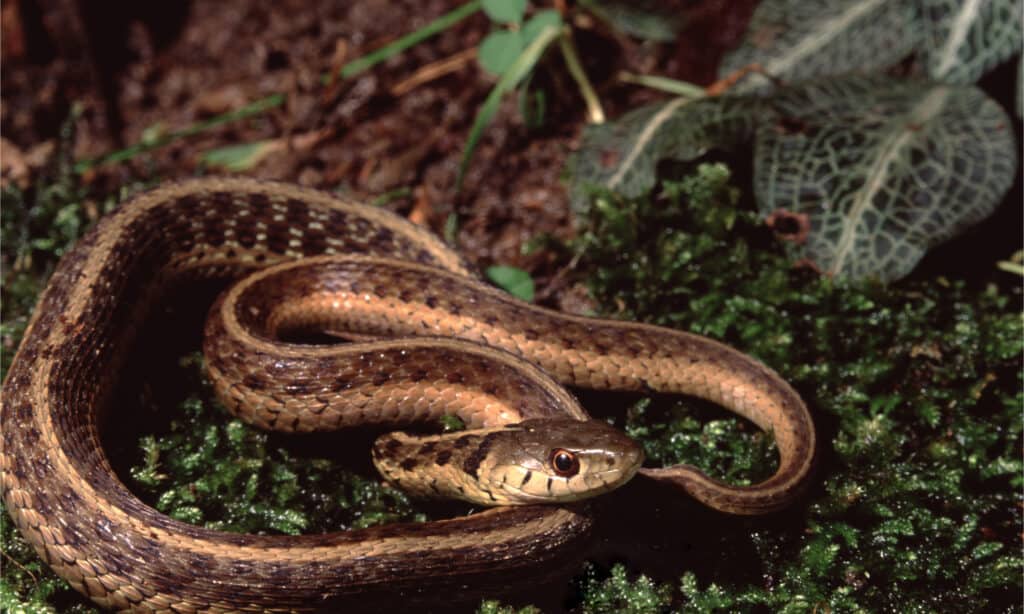
Northwestern garter snakes are highly variable, but three patterns are more common in Washington.
©Liz Weber/Shutterstock.com
2. Common Garter Snake (Thamnophis sirtalis ssp.)
This thin snake and its subspecies is present nearly everywhere snakes exist in Washington. Common garter snakes are daytime hunters that aren’t fussy about what they eat. They typically feast on small amphibians and earthworms, but they’ll also eat snails, slugs, crayfish, insects, fish, lizards, other snakes, small birds, and even rodents.
Although they’re not dangerous to people, common garter snakes have what you could call “venomous saliva.” It incapacitates their small prey, making it easier to swallow without too much struggle.
Common gartersnakes can measure up to four feet long and most have stripes down the length of their body. They can be many colors including blue, black, green, red, brown, orange, or yellow.
These snakes tend to operate on the idea that everything bigger is a threat. So they musk nearly immediately upon spotting you. Of course, some of them aren’t quite as nervous, but there’s a reason people call them stinky snakes.
At least three subspecies are found in Washington. However, to properly identify any garter snake species or subspecies, you almost always have to look at scale counts, color, and pattern. They’re all so similar looking that it’s sometimes difficult for experts to tell the difference.
- Red-spotted gartersnake (T. s. concinnus) — southwestern washington.
- Puget Sound Gartersnake (T. s. pickeringii) — Northwestern Washington.
- Possibly the valley Gartersnake (T. s. fitchi) — Rocky mountains.
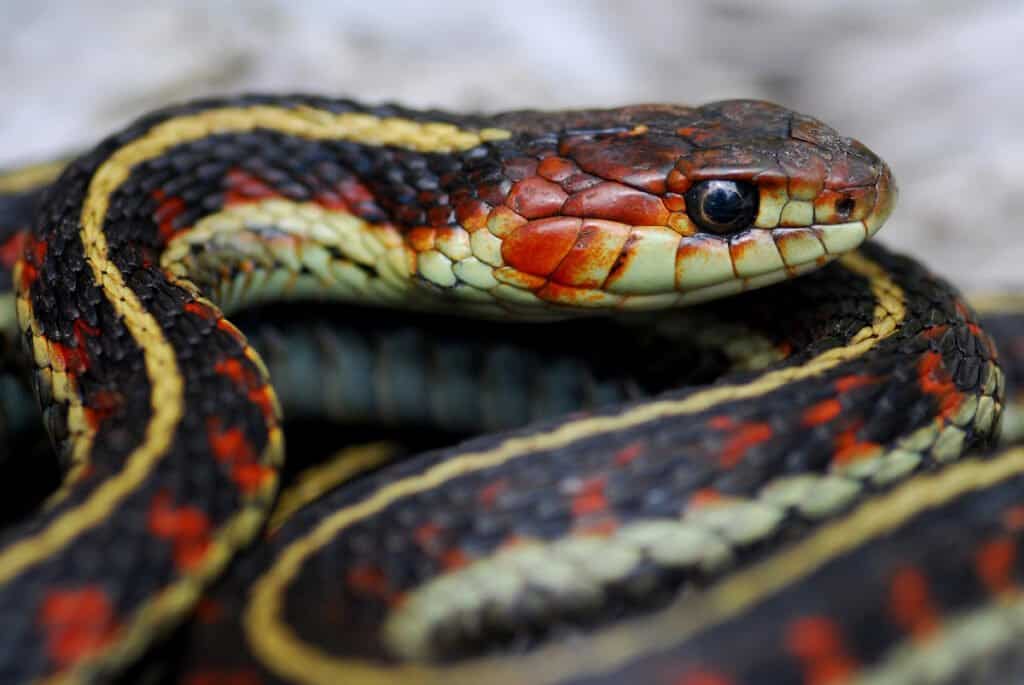
Valley garter snakes often have red spots on their sides.
©Jason Mintzer/Shutterstock.com
3. Gopher Snake (Pituophis catenifer)
Novenomous gophersnakes are common in the eastern half of Washington state. There used to be a western Washington species, but the Washington Department of Fish & Wildlife believes it is most likely extirpated.
So, what we’re left with is a big snake that can grow to six feet long and make itself look and sound like a venomous rattlesnake — which it’s not.
In Washington, gophersnakes are usually tan with dark brown squarish blotches on their back, smaller blotches on the sides, and a noticeable eye stripe. They also have vertical bars around their lips and a banded tail.
One of the biggest differences between gophersnakes and rattlesnakes is that gophersnakes do not have a rattle, but try to buzz their tail against the ground.
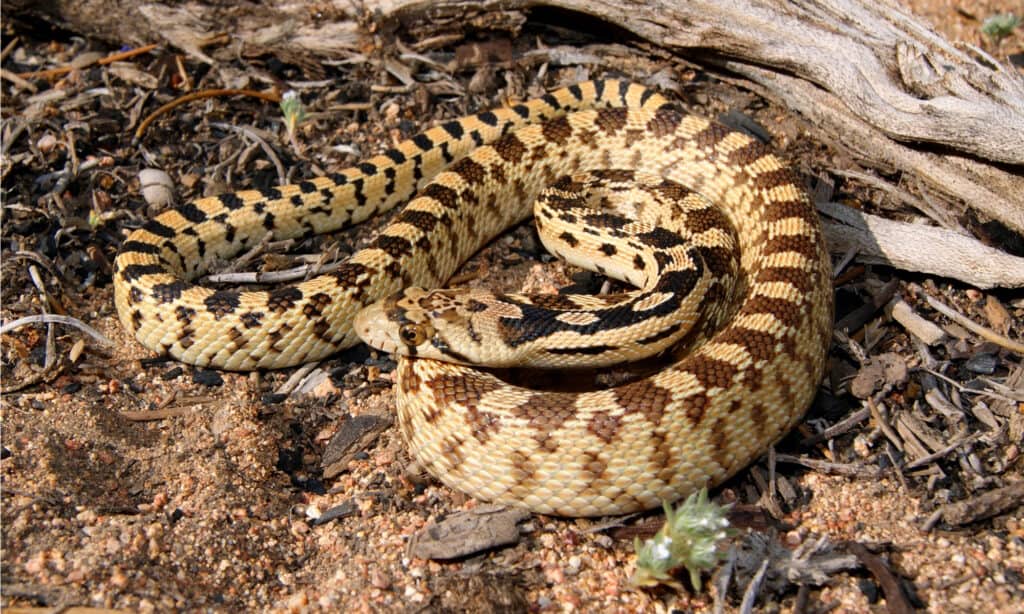
Great Basin Gopher Snake, Pituophis catenifer deserticola
©Matt Jeppson/Shutterstock.com
4. Sharp Tail Snake (Contia tenuis)
These snakes range from California north to British Columbia and their populations become thinner as you travel north. Rare in Washington, sharp tail snakes are also small and thin. They average between 12 and 18 inches long and very secretive.
Sharp-tail snakes’ dorsal side is red, grayish brown, or brick red; sometimes you can find a bubble-gum pink individual! Their belly pattern is black and white crossbars.
You’re most likely to find a sharp-tail snake under rocks or logs. They are almost never out in the open, but may come out of their hiding spot after a good rain. Most often, people find them when they’re digging in their garden or removing other debris.
Sharp-tail snakes mainly eat slugs and their eggs, but may also eat insects and earthworms. These nonvenomous snakes have an extra long vertebra in their tail, which works like a poker that holds their prey still.

You will find sharp tail snakes under rocks and logs on the forest floor.
©Bill Bouton / CC BY-SA 2.0 – License
5. Terrestrial Garter Snake (Thamnophis elegans)
Another harmless-to-humans but really common snake in Washington, the terrestrial or western terrestrial garter snake is widespread across the state. They usually have three stripes — the usual dorsal and two lateral. In these snakes, they’re usually cream or yellow colored.
These snakes have keeled scales (like other garter snakes), and often have dull colorations in comparison to some of the other species. Sometimes, their dorsal stripe is missing, and the spots on their back often overlap the stripe, and some terrestrial garter snakes may be more spotted than striped.
Like other garter snakes, there are several subspecies. The subspecies that occurs in Washington, the wandering garter snake (T. e. vagrans), grows to about 38 inches.
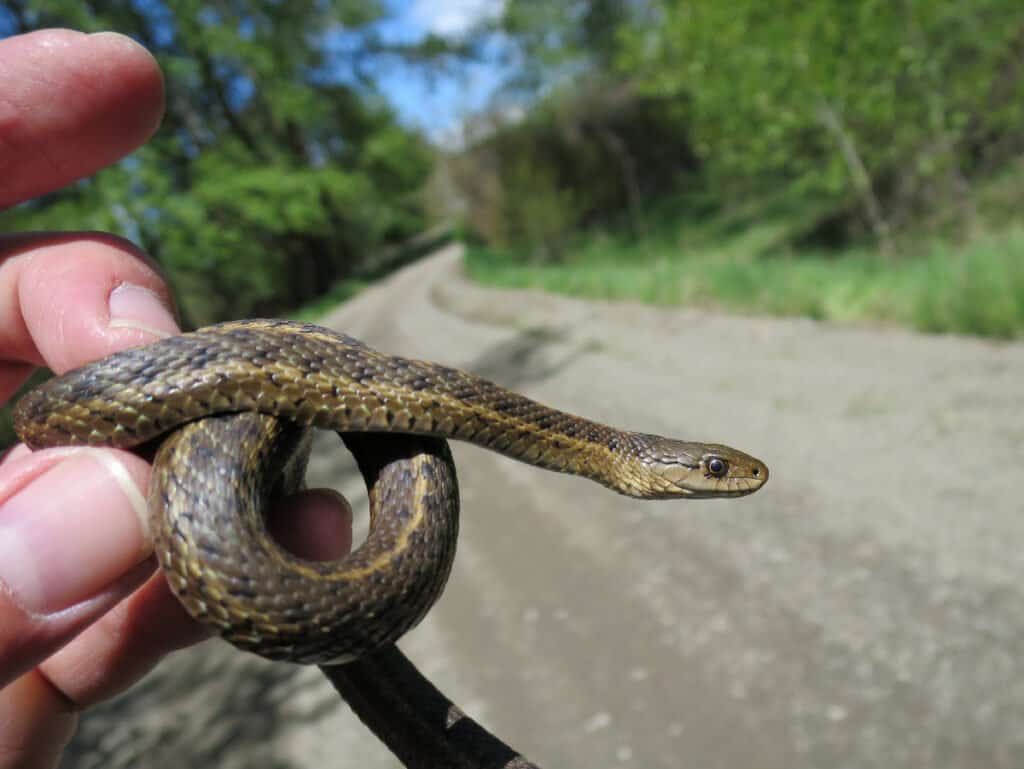
Terrestrial Garter Snakes are common across Washington state.
©Randy Bjorklund/Shutterstock.com
6. California Mountain Kingsnake (Lampropeltis zonata)
Washington is the extreme northern edge of the California mountain kingsnake’s range. There’s a small population just north of the Washington-Oregon border, which is the only place you’ll find them for 200 miles!
Most California mountain kingsnakes have red, black, and white bands, but they’re highly variable and you may find one that’s black and white. These nonvenomous colubrids are short and measure one and a half to three feet long.
Although at a quick glance, they resemble venomous coral snakes, they’re actually easy to differentiate simply by location — there are no coral snakes in Washington state. California mountain kingsnakes enjoy a diet rich in rodents, lizards, birds, and other snakes.

California mountain kingsnakes are often mistaken for venomous coral snakes due to their bold colors, but their ranges do not overlap.
©Matt Jeppson/Shutterstock.com
7. Northern Desert Nightsnake (Hypsiglena chlorophaea deserticola)
These little snakes are adorable. They’re a nightsnake subspecies local to the Pacific Northwest. Northern desert nightsnakes are venomous, but their venom isn’t medically significant for humans. On top of that, their tiny fangs are situated in the back of their mouth, making them sort of chew the venom into prey.
Northern desert nightsnakes only measure about 24 inches at their longest and have patterns reminiscent of gopher or rattlesnakes. They also have vertical pupils — if you can see them. Nightsnakes’ eyes are as small as they are.
These little snakes are adaptable and can live in many habitats including chaparral, woodlands, desert scrub, and moist meadows. They mainly eat lizards and frogs, but may also eat small snakes, salamanders, and even mice.
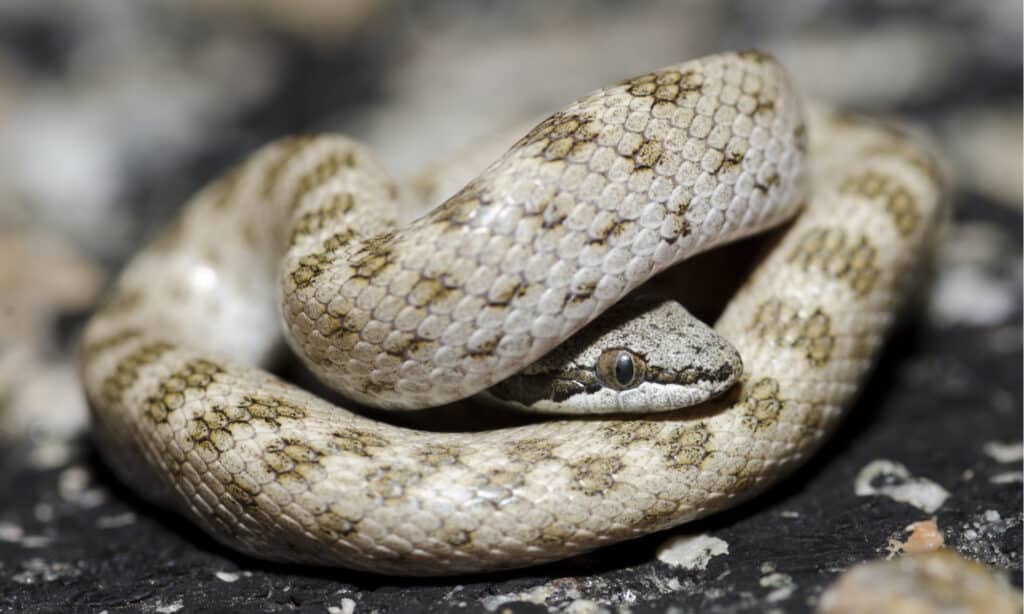
Northern Desert Nightsnakes are small and sometimes confused with gopher and rattlesnakes.
©Jason Mintzer/Shutterstock.com
8. Ring-Neck Snake (Diadophis punctatus)
A small harmless snake with a bright belly? Check! Ring-neck snakes aren’t as common in Washington as other snakes — the state is at the northwestern edge of their range.
These snakes are can grow up to 22 inches in the northwest and are often slate gray to greenish gray. Their names come from the bright-colored neck band that usually matches their belly — which in Washington is usually bright orange.
Most ring-neck snakes occur in the southern areas of Washington, along the Oregon border. However, there’s also a population in Kickitat and Yakima Counties, and in the east in Whitman County.
Ring-neck snakes mainly eat earthworms, small salamanders, and slugs. But they also eat small lizards, frogs, and young snakes.
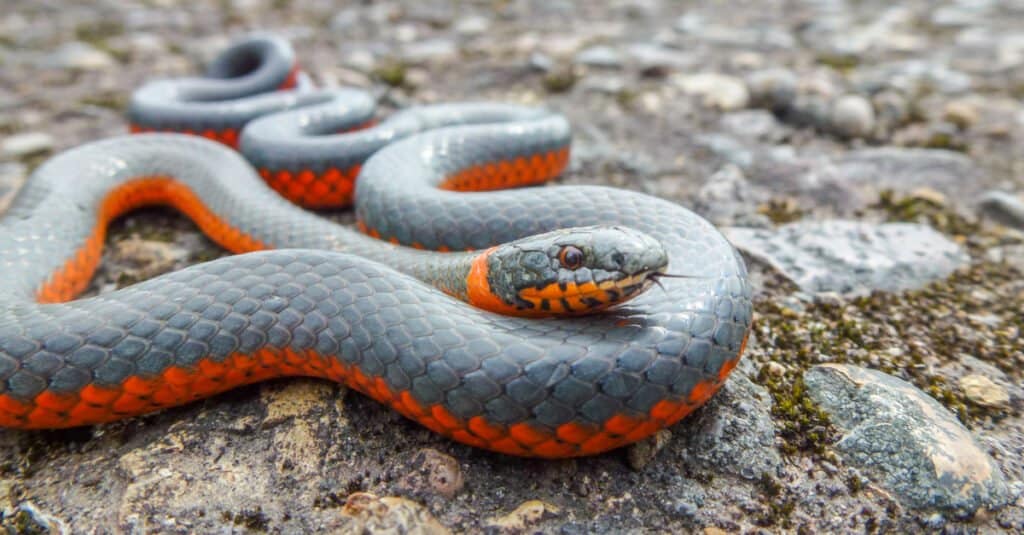
Ring-neck snakes aren’t common in Washington, most of them are found along the Washington-Oregon border.
©Tom Fenske/Shutterstock.com
9. Western Yellow-Bellied Racer (Coluber constrictor mormon)
North American Racers are hard to miss. They’re strikingly beautiful snakes that dart around at up to four miles per hour and are equally quick to bite you when cornered. Their 10+ subspecies are pretty common across most of the country, including eastern Washington state.
Western yellow-bellied racers occur primarily in the eastern half of Washington state. They grow up to six feet long and stay very slender. These snakes hatch with a blotched pattern and have large eyes for their head. As they grow, western yellow-bellied racers in Washington state lose their juvenile pattern and become solid colored brownish, gray, dark green, or blackish on the top with light-colored belly which is often yellowish.
Known for holding their heads above the ground while they’re hunting, western yellow-bellied racers sometimes climb into shrubs to see better. These snakes have excellent vision and hunt primarily during the day. They prefer grasslands near water, but are equally comfortable around trash piles, roadsides, and in the suburbs.
These snakes eat a steady diet of pretty much anything they can overpower. This can include rodents, birds, amphibians, and other snakes. Instead of constricting prey like their scientific name suggests, western yellow-bellied racers grab it in their mouth and use brute force to pin it against something to subdue it.
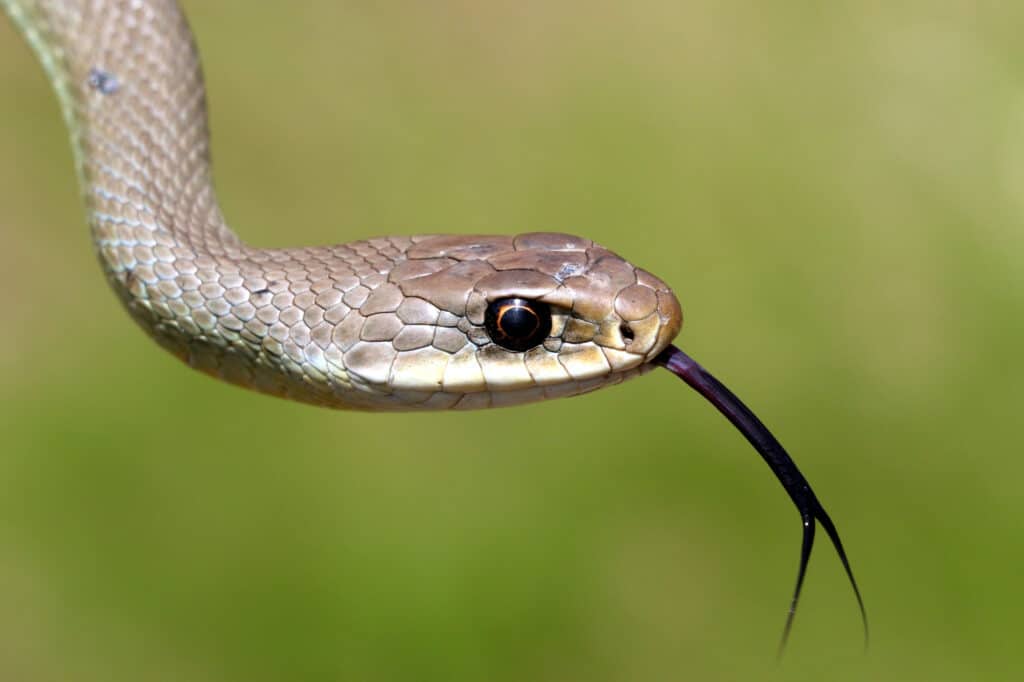
A Western Yellow-bellied Racer (Coluber constrictor mormon) with tongue out
©iStock.com/randimal
10. Desert Striped Whipsnake (Masticophis taeniatus taeniatus)
Desert striped whipsnakes’ prefer only the driest areas of the central Columbia Basin in shrubsteppe areas. Scientists believe the species was never common in Washington. However, their favorite habitats are in some of the same areas where land has been converted for agriculture and reservoirs, making their survival more difficult.
This is not only Washington state’s longest snake but also its rarest. Desert striped whipsnakes can reach six feet long and very thin. They’re usually black, gray, or dark brown with a bit of a greenish-blueish hue with two ore more cream to white stripes running the length of their body.
Desert striped whipsnakes have small heads with big eyes. They’re active daytime hunters that use excellent vision to track the lizards it eats, in addition to small mammals, birds, frogs, insects, and other snakes.

11. Northern Rubber Boa (Charina bottae)
Rubber boas are small, extremely docile boas native to areas of the western United States. In Washington, their population is patchy at best. Technically their range covers most of the state, but experts aren’t certain where exactly they are most common. Most reports are the result of an accidental sighting rather than a systematic study and the Washington Department of Fish & Wildlife believes that they’re probably more common than the numbers indicate.
This adorable little boa is secretive and nocturnal. Only measuring one to two and a half feet long, they are small. Their baggy skin is covered in tiny scales which, combined, give northern rubber boas a rubber-like texture.
Typically, they’re solid-colored and can be tan, dark brown, olive-green, yellow, or orange with a lighter belly color. Northern rubber boas have small eyes and short heads that look a lot like their tails — which is likely part of their defense. After all, if a predator can’t tell its head from its tail, where does it strike?
Rubber boas can live in many different habitats including meadows, grasslands, chaparral, and forests — even into alpine climates. They’re not fond of very dry or hot climates, but tolerate cold better than most boas.
Their diet is mostly made up of young mammals like voles, shrews, and mice. These snakes get into rodent nests and try to eat all the babies while they fend off the mothers with their tails. As a result, northern rubber boas often have extensive scarring on their tails.

Rubber boas are extremely docile and only about one to two and a half feet long.
©yhelfman/Shutterstock.com
12. Northern Pacific Rattlesnake (Crotalus oreganus) — the Only Venomous Snake In Washington State
You read that right! There’s only one venomous snake in all of Washington state. The northern Pacific rattlesnake is only really present in eastern Washington. Some sources call it the western rattlesnake, so be sure you know which species you’re looking at because the prairie rattlesnake (Crotalus viridis) also sometimes goes by western rattlesnake.
Northern Pacific rattlesnakes have colors that usually run the range of brown to olive. They have dark oblong-ish spots outlined in black and white with additional spots on the side of their body. Like other rattlesnakes, they have vertical pupils — but that’s not a defining characteristic! To identify these snakes, look for the pattern, the dark, wide eye stripe beginning right behind the eye, and chunky body that ends in a rattle or a button.
This species can grow to five feet or so but in Washington, most of them are around two feet. Northern Pacific rattlesnakes prey on various animals including rabbits, mice, birds, bird eggs, reptiles, amphibians, and even insects.
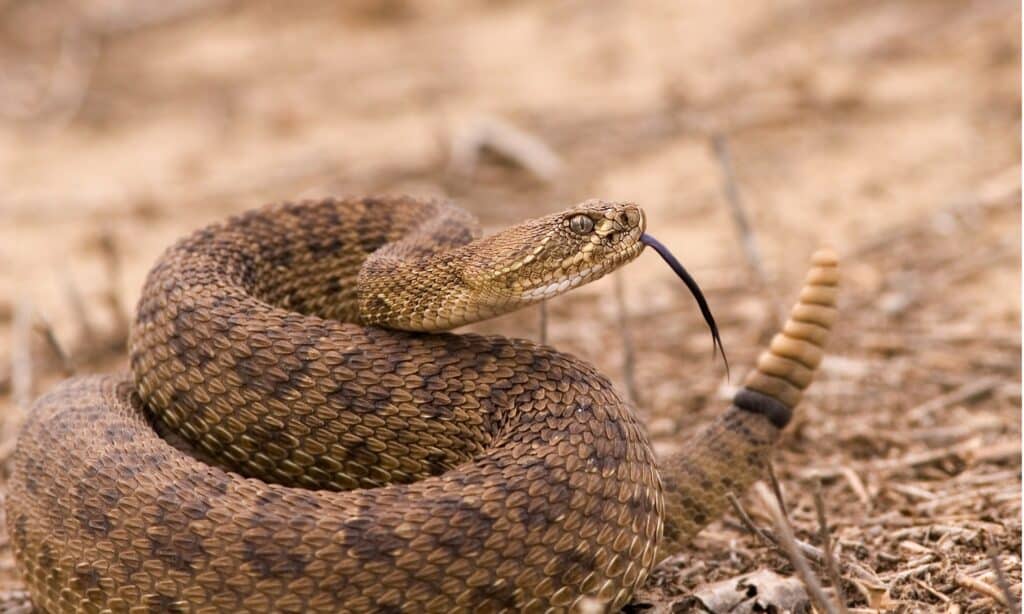
Western rattlesnakes are also called northern Pacific
rattlesnakes.
©iStock.com/SteveMcsweeny
A Complete List Of Snakes In Washington
Always keep an eye out for snakes when you are enjoying all the outdoor activities in Washington. Generally speaking if you leave them alone they will leave you alone, but if you see a venomous snake always be extremely careful.
| Snake Species | Venomous? | |
|---|---|---|
| 1 | Northern Pacific Rattlesnake | Yes! |
| 2 | California Mountain Kingsnake | No, they’re harmless |
| 3 | Gopher Snake | No, but often mistaken for rattlesnakes |
| 4 | Western yellow-bellied racer | No. However, they’ll bite if you corner them. |
| 5 | Desert Striped Whipsnake | No |
| 6 | Common Garter Snake | Sort of venomous saliva that’s harmless to humans |
| 7 | Northwestern Garter Snake | Harmless to humans |
| 8 | Western Terrestrial Garter Snake | Harmless to humans |
| 9 | Ring-Neck Snake | No |
| 10 | Sharp-Tail Snake | No |
| 11 | Northern Desert Nightsnake | Mildly, but harmless to humans |
| 12 | Rubber Boa | No |
The photo featured at the top of this post is ©
Discover the "Monster" Snake 5X Bigger than an Anaconda
Every day A-Z Animals sends out some of the most incredible facts in the world from our free newsletter. Want to discover the 10 most beautiful snakes in the world, a "snake island" where you're never more than 3 feet from danger, or a "monster" snake 5X larger than an anaconda? Then sign up right now and you'll start receiving our daily newsletter absolutely free.
FAQs (Frequently Asked Questions)
What type of venomous snakes live in Washington state?
There are quite a few venomous snakes in Washington state. Some of these snakes include Western Rattlesnake, Timber Rattlesnake, Northern Copperhead, and Western Massasauga Snake.
Does the weather in Washington prevent many snakes from living there?
Even though it can be pretty cold in Washington and snakes aren’t known for liking the cold there are more than 20 native snake species that are found in Washington. It might be a surprise that there aren’t a lot of water snakes in Washington considering how much water the state has. But most of the snakes in Washington like wooded habitats or rocky ledges like those found in the mountains of Washington.
Thank you for reading! Have some feedback for us? Contact the AZ Animals editorial team.







